Thursday, October 31, 2013
Making Home Theater 5 1 Surround Amplifier

For clarity I give a simple illustration of the layout and the circuit for these speakers.
 |
| 5.1 Speaker Setup |
Accoustic Field Generator
Acoustic Field Generator is generating acoustic sound with surround effects are adjustable with a standard Dolby Surround, able to produce surround sound is good enough but not too much need of funds. Technological developments as if not only focused on one area alone but on all fronts. The development of technologies that exist today one of them is in the field of audio. With more advanced audio technology today not only as mere entertainment but has become a hobby, hobby is not cheap of course. Many audio enthusiasts trying to make music sound that sounded to be very hard to make music sound as live, the addition of the amplifier, woofer or special speakers that cost is not cheap.
The sound effects are living seems to now is something that most do not have to exist in every good audio devices. This effect is basically a surround effect that can lead to sound as though coming from different directions and his voice can still be heard clearly. Currently Compo-tape tape that has been a lot of these facilities surround sound but not good enough when heard from a considerable distance because of the effects surroundnya missing. This is because the distance is too far listener and speaker, speaker layout is not quite right, or the effect of unfavorable surround.
Surround effects are nice and can be heard with a good surround system is a system that is in movie theaters and to make it not a bit prangkat needed funds. However, if satisfaction remains the number one then the fund is not a major problem. To find a middle ground between price and quality surround effects it was attempted to make the Acoustic Field Generator that can produce surround sound is good enough but not too much need of funds. Acoustic Field Generator is capable of generating acoustic sound with surround effects are adjustable with a standard Dolby Surround.
Accoustic Field Generator Construction
Basically an Acoustic Field Generator built from op-amp circuit and filters. Op-amps are usually used as a voltage amplifier in the Acoustic Field Generator is more widely used as active filters. The filter in the tool is very instrumental in creating an acoustic sound that is really clear, but in practice, almost all the filters, do not miss the precision of the signal with a specific frequency. An op-amp is good for this application is the op-amp which has a wide bandwidth, rise time, slew rate and fast setting timenya. In addition to op-amp and active filter, theres more important parts of the power supply. This is the part that is instrumental in creating excellence acoustic sound because of the bad power supply which is the only producer of noise, which will enter into a voice signal path so that should clear acoustic sound into an acoustic sound with the addition of reverberation (noise). The power supply used is the twin power supply + / - 18 volts DC. Part Acoustic Field Generators
Before we start doing this project, it helps us know in advance about the function of each speaker.
Channel Front is a forward channel input signal LR. LR signal is passed to an amplifier with gain = 1 so that this signal is passed without change / to filter the input signal LR. Front Left and Front Right, is a public speaker that we encountered in stereo amplifier, consisting of a woofer and tweeter. Woofers generally produce low tone sound with a frequency range ranging from 80Hz - 250Hz, while the tweeter produces a high tone with a frequency range between 15kHz - 20kHz. For projects that we will create, its good we use a good quality woofer, with a size of 10 inches and a type piezoelectric tweeter for each speaker fronts.
 |
| Front Channel 5.1 Amplifier |
Center Channel
Center, the fullrange speakers, which produce sound with a frequency range between 80Hz - 10Khz. Output from the center speaker is a summation of left and right signal (left + right = center). In a movie or song Dolby Surround format, commonly used center for dialogue / vocal or speech of the actor / artist of a film and to produce a sound that moves ahead of us.
 |
| Center Channel 5.1 Amplifier |
Rear Channel with Surround System
 |
| Rear Channel 5.1 Amplifier |
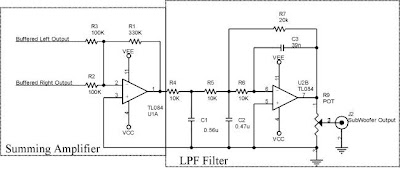 |
| Subwoofer Channel 5.1 Amplifier |
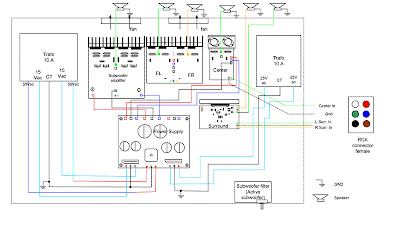 |
| Wiring Diagram Home Theater Amplifier / 5.1 Amplifier |
Wednesday, October 30, 2013
Triac Optimization Circuits
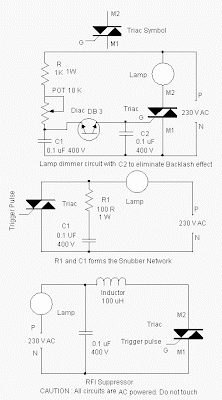 |
| Triac Optimization Circuit | Click image to view larger |
- Conclusive voltage to MT2 and positive pulse to gate
- Positive voltage to MT2 and off-putting pulse to gate
- Negative voltage to MT2 and positive voltage to gate
- Negative voltage to MT2 and negative voltage to gate
Tuesday, October 29, 2013
Simple Sound to Light Converter Schematic Diagram
 Simple Sound-to-Light Converter Schematic Diagram
Simple Sound-to-Light Converter Schematic DiagramFigure 1 shows a simple ambit for converting an audio arresting (such as one that comes from the apostle terminals of a CD player). The ambit basically consists of a buffer/amplifier date and three clarify circuits: a high-pass filter, a mid-pass filter, and a low-pass filter. The achievement of anniversary clarify ambit drives a light-emitting diode of altered color.
The ascribe arresting is fed to the absorber date through C1. The ethics of RF and RV1 should be called so that the absorber is able to drive the three filters absorbed to its output. The low-frequency, mid-frequency, and high-frequency apparatus of the ascribe arresting are alone accustomed to canyon through the low-pass clarify (bottom filter), the mid-pass clarify (middle filter), and the high-pass clarify (topmost filter), respectively, appropriately amid them from anniversary other.
Changes in the achievement of a clarify account its agnate achievement LED to about-face on and off. In effect, agriculture a connected audio arresting to the ascribe of this ambit causes the LEDs to dance.
Monday, October 28, 2013
Dual Power Supply Circuits
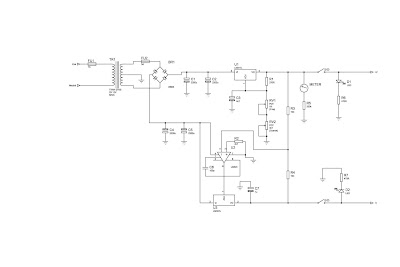 |
| Click to view larger |
Sunday, October 27, 2013
High current output switching power supply
This is low voltage high-current ouput , switching dc power supplly wiht input 220 Volts AC , In this circuit , an St2 diac relaxation oscilator, Q3 , C1 , and the diac , initiates conduction of the output switching transistor Q1, the on time of which is maintained constant by a separate timing / commutation network consisting of Q2 , C2 ,SUS , and SCR 1. See schmeatic diagram below :

The output voltage , consequently , is independent on the duty cycle . To compensate for unwanted variations of output voltage because of input voltage or load resistance fluctuations , an H11C wired as a liniear - model unilateral pnp transistor in a stable different amplifier configuration is connected into the galvanically isolated negative- feedback loop.
Saturday, October 26, 2013
High Efficiency White LED Driver Using with NCP5680
High Efficiency White LED Driver Circuit diagram

Friday, October 25, 2013
Touch Activated Light

Thursday, October 24, 2013
Heat Sensor Fire Detector Pyroelectric

These sensors form of Lithium Tantalate pyroelectric parallel opposed dual element high gain detector with integrated analog signal processing. These sensors can detect heat changes from -40 to +70 degrees Celsius without change siginfikan of noise and sensitivity.
Wednesday, October 23, 2013
6 5W audio power amplifier

This amplifier circuit based on the ic, and the use here is that where ic STK4017 IC has output power of 6.5 watts with the impedance 8Ohm. Minimum required supply voltage and maximum 20Volt 35 Volt DC.Component
R1 = 100K
R2 = 2K7
R3 = 27R
C1 = 22uF
C2 = 100uF
C3 = 100uF
C4 = 100uF
C5 = 100uF
C6 = 47uF
C7 = 330uF
C8 = 100uF
U1 = STK4017
Besides using STK4017 ic, ic and can use that I mentioned the following:
STK4019
STK4021
STK4023
STK4025
Tuesday, October 22, 2013
DAC with MCS5 Microcontroller

Digital scale is given to the B1 to B7 (leg 5 to 12) in the IC DAC0800, the binary value of the digital scale was converted into an analog magnitude of the current at IOUT (ft 4 DAC0800) and IOUT * (feet 2 DAC0800), then by IC Operational Amplifier LM741 flow is converted into voltage. The resulting voltage expressed by the formula shown in Figure below, in addition to depending on a digital scale weight value is given, this voltage depends on the size of Vref (DAC0800 14 feet).
 |
| figure.1 DAC With MCS5 Microcontroller |
In Figure 1, the DAC0800 is connected to the parallel port P1 from AT89Cx051. Connecting the DAC0800 to the other MCS51 family, for example AT89C51, can pass parelel ports P0, P1, P2 or P3, depending on the conditions established series. Instructions to remove the voltage in the circuit of Figure 1 is very simple, just use instruction MOV P1, A analog scale with the understanding that wish to be raised previously been stored in the accumulator A.
Monday, October 21, 2013
2 X 20 Watt Car Amplifier
This is a very simple circuit power amplifier with IC LA4440. This circuit is a circuit the first time i learned to make a power amplifier. Power output 2 X 20 Watt with stereo speakers. Minimum Voltage 9 Volt and maximum voltage 24 V. The Circuit is also very easy to make. For novices , this circuit is suitable for use . The material is also readily available at electronics store.
See schematic below :

Sunday, October 20, 2013
Modifying your Auto Sound System
Saturday, October 19, 2013
Insect Repeller Circuit Diagram
 In this section we talk about a type of insect repellent insect repellent is a circuit that repel insects from your home or garden effectively. This circuit uses the frequency of bullying of insects to the insect goes.
In this section we talk about a type of insect repellent insect repellent is a circuit that repel insects from your home or garden effectively. This circuit uses the frequency of bullying of insects to the insect goes.IC 4047 Description
 Absolute Maximum Ratings IC IC 4047
Absolute Maximum Ratings IC IC 4047DC Supply Voltage (VDD)...........-0.5V to +18VDC
Input Voltage (VIN)...............-0.5V to VDD +0.5VDC
Storage Temperature Range (TS)....-65°C to +150°C
Power Dissipation (PD)
Dual-In-Line...................... 700 mW
Small Outline..................... 500 mW
Lead Temperature (TL)
(Soldering, 10 seconds)........... 260°C.
Friday, October 18, 2013
NJM2035 High Quality Stereo Encoder
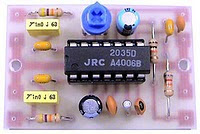

Technical Specifications:
Supply Voltage: 1.2V - 3.6V MAX
Current Draw:> 3mA
Channel Separation: <25 dB
Signal to Noise Ratio: 67 dB
Operation Temperature: -20 - 75 ° C
Frequency Range: 20Hz - 15KHz
Component List:
R 2x 47K
R 1x 10K
R 1x 82K
VR 1x 50K POT
C 1x 33uF
C 1x 10uF
C 3x 100nF (104)
C 1x 100pF (101)
C 1x 10pF (10)
1x IC IC NJM2035
1x XT 38 KHz Crystal
Thursday, October 17, 2013
Inverter 5000W with PWM Pulse Width Modulator
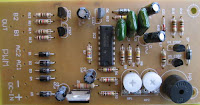
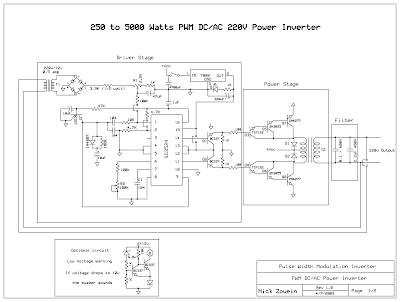 |
| Schematic Inverter 5000W with PWM (Pulse Width Modulator) |
 |
| Layout PCB Inverter 5000W with PWM (Pulse Width Modulator) |
below is the output power settings that can be issued by this inverter:
DC voltage and Transformer "T2" winding recommendation:
Winding Power Supply
12VDC 750W P: 24V "12-0-12" / S: 220V
1500W 24VDC P: 48V "24-0-24" / S: 220V
2250w 36VDC P: 72V "36-0-36" / S: 220V
3000w 48VDC P: 96V "48-0-48" / S: 220V
3750w 60VDC P: 120V "60-0-60" / S: 220V
4500w 72VDC P: 144V "72-0-72" / S: 220V
5250w 84VDC P: 168V "84-0-84" / S: 220V
Transformer used is the transformer CT
R1 serves to regulate the voltage to 220v inverter
R2 serves to regulate the inverter output frequency of 50 or 60 Hz (as appropriate)
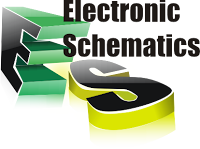
Wednesday, October 16, 2013
A Basic IR Link
A basic Imfra Red Link for audio communication for distances upto 3 metres.

Ovo je shema jednostavne bez?i?ne komunikacije sa malo komponenata .Diode d1 i d2 su infracrvene le-diode ,a foto transistor je tako?er infracrveni radi ?to manjeg vanjskog utjecaja .Domet ure?aja je oko 3m no on se mo?e promijeniti brojem le-dioda i naponom koji se dovede na diode.Na izlaz se ?ak mogu i direktno spojiti slu?alice.Link mo?e poslu?iti i za prijenos drugih vrsta signala..Na popisu komponenata nema kriti?nih dijelova i izrada sklopa je jako jeftina. Uz malo pa?nje ne moe da ne radi.
P.S Transistors can be replaced with 2N3904 and 2N2222
Notes:
In his circuit Milan has created a basic Infra Red transmitter and receiver. The transmitter comprises a single amplifying stage driving two series connected IR LEDS. The input source is connected to J1. Please note that the device will pass a small DC current through it and also directly bias the transistor. A suitable device is therefore a high output crystal microphone. These can produce high output voltages up to 1 Volt but this will be reduced by the transistors low input impedance.
The receiver is three stages, the first stage being a phototransistor. Stages two and three form a high gain darlington emitter follower, the bias for the whole stage derived through R2 and the phototransistor itself. C1 and R3 form a filter to reduce interference from flourescent lighting and other hum sources. The output is via Jack J2. Note also that the output device will pass a small DC current so a medium impedance loudspeaker or hwadphones are a good choice here.
Tuesday, October 15, 2013
20W amplifier schematic with mute
This is a series of audio amplifier using ic and equipped with a mute switch. This circuit using ic and has 20W output impedance 4 ohms. Scheme and a list of components can be seen below.

Part List :
Resistor
R1 = 3.3K
R2 = 39R
R3 = 39R
R4 = 3.3K
R5 = 3R
R6 = 3R
Capacitor
C1 = 1uF
C2 = 1uF
C3 = 10uF
C4 = 100uF
C5 = 100uF
C6 = 220uF
C7 = 0.1uF
C8 = 0.1uF
IC
IC = ULN3793W
Monday, October 14, 2013
Transmitter and Receiver AM Superheterodyne
 |
| Transmitter |
 |
| Receiver |
Sunday, October 13, 2013
LM4651 and LM4652 170W power amplifier
Part of this power amplifier driver using the LM4651 IC designed specifically for the purpose of the class AB amplifier driver with short circuit protection feature, containing under voltage, thermal shutdown protection and standby functions. Section 170 Watt power amplifier using LM4651 IC with a MOSFET power amplifier is equipped with temperature sensors that will be used by IC LM4651 as controlnya thermal signal. IC IC LM4651 and LM4652 are designed specifically to each other in pairs to create a class AB power amplifier with protection features are detailed. Detailed series of 170 Watt power amplifier can be seen in thethe following figure .

Power amplifier circuit requires supply voltages +22 V DC symmetrical 0-22V. Power Amplifier with IC LM4651 and LM4652 are often used in portable HiFi systems such as powered speakers, power subwoofer and car audio power Booter. D1, D2, D3 and D4 in series 170 watt power amplifier with LM4651 and LM4652 is a 22V zener diode.
Saturday, October 12, 2013
Basic Automatic Day Night Lamp with LDR

Maybe its a lot who know how to work this one series, but I wanted to share back to the beginner on this. In the existing lighting circuit automatic lights that use components LDR (Light Dependence Resistor).
The workings of LDR LDR is exposed to light if the layer of the resistance was weakened likewise if there is no light at all resistance enlarged. here could make friends like that, because its components are a little easy but we will use the 220V AC voltage of course you must be very careful. Rather than actually being burnt. The author asks to be careful for the beginner course.
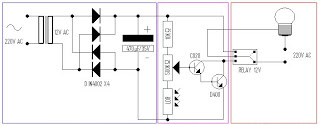 |
| Schematic LDR |
Friday, October 11, 2013
Circuit High Voltage Generator with HEX FET

Thursday, October 10, 2013
Amplifier Output Delay with Relay
 |
| Amplifier Output Delay with Relay Circuit Diagram |
Wednesday, October 9, 2013
Ebay has Surprising Bargains on Auto Sound Systems
 Many people often find better deals when going through Ebay than they would even be able to find at many retailers online. I am constantly amazed at the wonderful bargains that can be found on Ebay not only when it comes to auto sound systems but full entertainment packages for your vehicle. Not only can you find great bargains on sound systems for your vehicle you also can find some thrifty deals on amplifiers, subwoofers, speakers, speaker systems, and tools, tips, and tricks when it comes to installation.
Many people often find better deals when going through Ebay than they would even be able to find at many retailers online. I am constantly amazed at the wonderful bargains that can be found on Ebay not only when it comes to auto sound systems but full entertainment packages for your vehicle. Not only can you find great bargains on sound systems for your vehicle you also can find some thrifty deals on amplifiers, subwoofers, speakers, speaker systems, and tools, tips, and tricks when it comes to installation.Tuesday, October 8, 2013
Basic Principles of the LC resonance circuit

Monday, October 7, 2013
1W Audio Amplifier Using NCP2830
1W Audio Amplifier Circuit using NCP2830

Sunday, October 6, 2013
High Gain Crystal Earphone Amplifier
 High Gain Crystal Earphone Amplifier
High Gain Crystal Earphone Amplifier
Saturday, October 5, 2013
Fire alarm with light sensor

Friday, October 4, 2013
Audio Surround Decoder Circuit

Component List :
R1-2-7-8-12-13-18-19-20 : 47Kohm
R3-4-5-6-21-22-34-35 : 10Kohm
R9-10-11-14-15-16-17 : 15Kohm
R23-24-25-33-36 : 100ohm
R26-27-28-31-32 : 100Kohm
R29-30 : 5.6Kohm
C1-8 : 47uF/25V
C2-7-9-14-23 : 47nF
C3-6 : 1uF/100V
C4-5-10 : 33pF
C11-12-15 : 10uF/25V
C13 : 82nF
C16 : 18pF
C17 : 100pF mini adjustable capacitor
C18 : 2.2nF
C19 : 4.7uF/25V
C20 : 100nF
C21 : 10nF
C22 : 180pF
C24 : 150nF
RV1-RV2 : 2 X 10Kohm Log. pot.
RV3-4 : 10K Log pot.
D1 : 1N4148
IC1-6 : TL072
IC2-3 : TL074
IC4 : MN3101
IC5 : MN3004
Thursday, October 3, 2013
300W subwoofer amplifier schematic
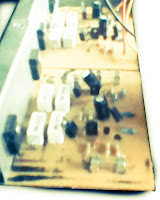 This is an amplifier circuit that is formed from a transistor amplifier miraculous. This circuit is used in the speaker subwoofer with 300W maximum power on each side. To apply it, can be used in the room that is not too large, like the car. And the voltage needed between 25 to 42 Volt DC.
This is an amplifier circuit that is formed from a transistor amplifier miraculous. This circuit is used in the speaker subwoofer with 300W maximum power on each side. To apply it, can be used in the room that is not too large, like the car. And the voltage needed between 25 to 42 Volt DC.
Wednesday, October 2, 2013
Ultra Low Power LCD Indicator

The display that I used has three digits and 2 decimal points for a total of 23 segments. Different groupings of segments can be used for the four indicators. I chose to use three squares (shown) and the three lower segments together (not shown) for the four indicators. Many other combinations could be used, one possibility would be to hard-wire numbers or letters out of each of the digits. Other LCD displays could also be used for different effects.
Circuit Diagram

A part that doesnt exist as far as I know, but should, is a single pixel LCD indicator (2 wire). An LCD manufacturer could probably make a lot of money with such a part. If such a thing exists, Id love to hear about it.
Specifications:
Operating Voltage: 3-15V (5V Nominal) DC
Operating Current: 250 microamps to 1 milliamp (400 microamps at 5V)
Operating Frequency: approximately 60 Hz
Theory:
The 7555 IC (CMOS 555 timer) generates a square wave clock signal at approximately 60 hz. This signal is sent to the LCD backplane and the inputs of the four CMOS 4070 XOR gates. If the other input (ind*) of an XOR gate is low, the gates output is a square wave that is in phase with the clock signal. If the ind* input is high, the gates output is out of phase with the clock.
Sending a signal to an LCD segment that is in phase with the backplane signal causes the display to stay blank. Sending an out of phase signal to the LCD segment causes an AC waveform to be applied to the segment which turns it black. Multiple segments are wired in parallel to generate the desired display patterns. The LCD segments require a tiny amount of current to operate, the CMOS gates also take very little power, hence the efficient nature of the circuit. It is necessary to tie the unused segments to the LCD backplane, otherwise they may partially turn on.
If more dislay bits are needed, additional XOR gates can be connected in the same manner. Up to 23 XOR gates could be used to drive the entire display, but a microprocessor and driver software would probably be easier to put together. By generating all of the signals with a microprocessor, all of the driving circuitry can be eliminated.
Other logic families could be used to make this circuit, it should work with a standard 555 timer chip and a 74LS86 XOR gate (different pinout), for example.
Some LCDs may not operate at very cold temperatures, an engineer at Lumex said that their components will work from -30C to +75C.
Construction:
The circuit was built on a standard prototyping plug board. All of the parts can be purchased for under ten dollars.
Use:
The four inputs of the CMOS 4070 IC can connect to outputs on a microprocessor, or any other logic output that needs monitoring. The supply voltage of this circuit should be the same as the driving logics supply voltage.
Parts:
1X Lumex LCD-S301C31TR 3 digit LCD display (from Digi-Key), or equivalent
1X CMOS 4070 quad XOR Gate, a CMOS 4030 should also work.
1X 7555 CMOS 555 timer chip
2X 100nF capacitor
1X 100uF 25V electrolytic capacitor
1X 10K 1/4W resistor
1X 100K 1/4W resistor
Tuesday, October 1, 2013
10W Audio Amplifier with Bass boost
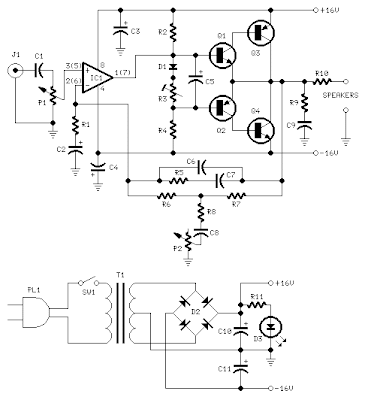
As amplifiers of this type are often used to drive small loudspeaker cabinets, the bass frequency range is rather sacrificed. Therefore, a Bass Boost control was inserted in the amplifier feedback loop, in order to overcome this problem, without loss of quality. The low elevation curve can reach a maximum of 16.4 dB @ 50Hz. In any case, even when the bass control is turned fully counterclockwise, the amplifiers frequency response curve shows a gentle rise: 0.8 dB at 400 Hz, 4.7 dB at 100 Hz and 6 dB at 50 Hz (referred to 1 kHz).